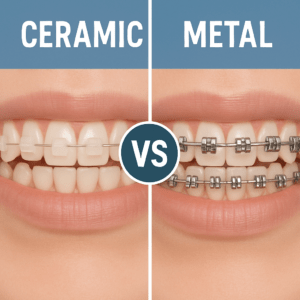
Metal vs Ceramic Braces: Choosing the Right Braces in Kolkata | City Smiles
Let’s Talk About Braces
When choosing the right braces for your treatment in Kolkata, you need to consider two main decisions. First, you’ll have to decide on the material—metal or ceramic. Second, you must choose between traditional braces and self-ligating braces.
What Are Metal Braces?
As the name suggests, metal braces are made of stainless steel brackets that hold the wire used to move your teeth. They’ve been used for over a century and are known for their strength and ability to handle even complex tooth movements. Metal braces are also the most cost-effective option, making them a popular choice among patients. The main drawback is their metallic appearance, which some people find less aesthetic.
What Are Ceramic Braces?
Ceramic braces are similar in function to metal braces but are made of tooth-colored or white ceramic material. This makes them blend better with natural teeth, offering a more discreet look. They are especially popular among adults and teens concerned about aesthetics during orthodontic treatment.
Are Ceramic Braces Better Than Metal Braces?
Not necessarily. While ceramic is generally a more brittle material than metal, the ceramics used in orthodontics are specially engineered to be strong and reliable. Both metal and ceramic braces offer the same effectiveness in terms of tooth movement. The main difference lies in their appearance, not their performance.
Are Ceramic Braces More Expensive?
Yes, ceramic braces typically cost more than metal braces due to the material and aesthetics. However, there is no difference in treatment duration—the length of your treatment depends on the complexity of your case, not the material of the braces.
Traditional Braces vs. Self-Ligating Braces
To understand the difference, it helps to know how braces work. Small brackets are bonded to the outer surface of each tooth, and a wire runs through these brackets. The wire applies pressure to move the teeth gradually into position.
- In traditional braces, the wire is held in place using elastic bands or small ligature wires.
- In self-ligating braces, the brackets have a built-in locking mechanism that holds the wire in place without the need for additional ties.
Self-ligating braces reduce friction, require fewer adjustments, and are often more comfortable for the patient. They may also shorten the overall treatment time in some cases.
Feature | Traditional Braces | Self-Ligating Braces |
Bracket Mechanism | Uses elastic or metal ties to hold wires in place | Uses a built-in clip to secure the wire |
Comfort | More friction, can cause more discomfort | Less friction, generally more comfortable |
Appointments | Requires more frequent visits for adjustments | Fewer visits needed due to efficient wire movement |
Treatment Time | May take longer depending on case complexity | Often faster due to continuous gentle force |
Oral Hygiene | More difficult to clean due to elastic ties | Easier to clean – no elastic ties to trap food |
Aesthetics | Metal or ceramic options available | Available in metal and clear ceramic options |
Cost | Lower initial cost | Slightly higher due to advanced technology |
Ideal For | Patients looking for effective, affordable treatment | Patients seeking more comfort and efficiency |
Conclusion
In the end, no matter which type of braces you choose, the final outcome—a beautifully aligned smile—is generally the same.
Ceramic braces are less noticeable than metal braces, making them a popular choice for those concerned about appearance. Self-ligating braces use advanced technology to apply gentler pressure, offering more comfort and often reducing overall treatment time compared to traditional braces.
Ultimately, whether you choose metal, ceramic, traditional, or self-ligating braces, the goal remains the same: effective, long-lasting results.
Book your appointment today at City Smiles Dental Care. Call us now

